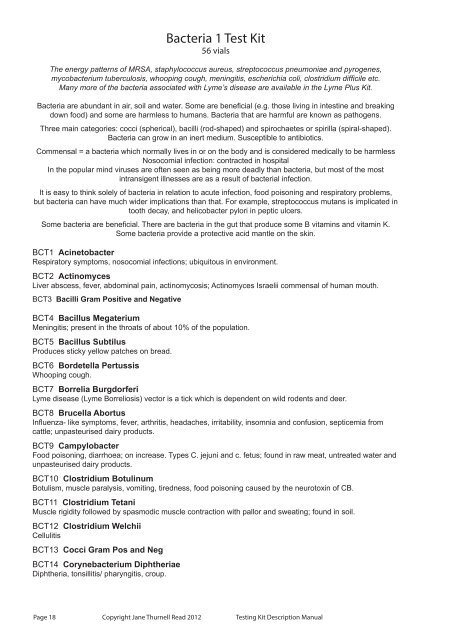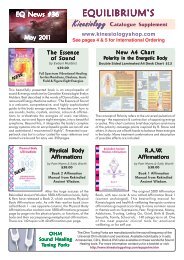You also want an ePaper? Increase the reach of your titles
YUMPU automatically turns print PDFs into web optimized ePapers that Google loves.
Bacteria 1 Test Kit<br />
56 vials<br />
The energy patterns of MRSA, staphylococcus aureus, streptococcus pneumoniae and pyrogenes,<br />
mycobacterium tuberculosis, whooping cough, meningitis, escherichia coli, clostridium difficile etc.<br />
Many more of the bacteria associated with Lyme’s disease are available in the Lyme Plus Kit.<br />
Bacteria are abundant in air, soil and water. Some are beneficial (e.g. those living in intestine and breaking<br />
down food) and some are harmless to humans. Bacteria that are harmful are known as pathogens.<br />
Three main categories: cocci (spherical), bacilli (rod-shaped) and spirochaetes or spirilla (spiral-shaped).<br />
Bacteria can grow in an inert medium. Susceptible to antibiotics.<br />
Commensal = a bacteria which normally lives in or on the body and is considered medically to be harmless<br />
Nosocomial infection: contracted in hospital<br />
In the popular mind viruses are often seen as being more deadly than bacteria, but most of the most<br />
intransigent illnesses are as a result of bacterial infection.<br />
It is easy to think solely of bacteria in relation to acute infection, food poisoning and respiratory problems,<br />
but bacteria can have much wider implications than that. For example, streptococcus mutans is implicated in<br />
tooth decay, and helicobacter pylori in peptic ulcers.<br />
Some bacteria are beneficial. There are bacteria in the gut that produce some B vitamins and vitamin K.<br />
Some bacteria provide a protective acid mantle on the skin.<br />
BCT1 Acinetobacter<br />
Respiratory symptoms, nosocomial infections; ubiquitous in environment.<br />
BCT2 Actinomyces<br />
Liver abscess, fever, abdominal pain, actinomycosis; Actinomyces Israelii commensal of human mouth.<br />
BCT3 Bacilli Gram Positive and Negative<br />
BCT4 Bacillus Megaterium<br />
Meningitis; present in the throats of about 10% of the population.<br />
BCT5 Bacillus Subtilus<br />
Produces sticky yellow patches on bread.<br />
BCT6 Bordetella Pertussis<br />
Whooping cough.<br />
BCT7 Borrelia Burgdorferi<br />
Lyme disease (Lyme Borreliosis) vector is a tick which is dependent on wild rodents and deer.<br />
BCT8 Brucella Abortus<br />
Influenza- like symptoms, fever, arthritis, headaches, irritability, insomnia and confusion, septicemia from<br />
cattle; unpasteurised dairy products.<br />
BCT9 Campylobacter<br />
Food poisoning, diarrhoea; on increase. Types C. jejuni and c. fetus; found in raw meat, untreated water and<br />
unpasteurised dairy products.<br />
BCT10 Clostridium Botulinum<br />
Botulism, muscle paralysis, vomiting, tiredness, food poisoning caused by the neurotoxin of CB.<br />
BCT11 Clostridium Tetani<br />
Muscle rigidity followed by spasmodic muscle contraction with pallor and sweating; found in soil.<br />
BCT12 Clostridium Welchii<br />
Cellulitis<br />
BCT13 Cocci Gram Pos and Neg<br />
BCT14 Corynebacterium Diphtheriae<br />
Diphtheria, tonsillitis/ pharyngitis, croup.<br />
Page 18 Copyright Jane Thurnell Read 2012 Testing Kit Description Manual



